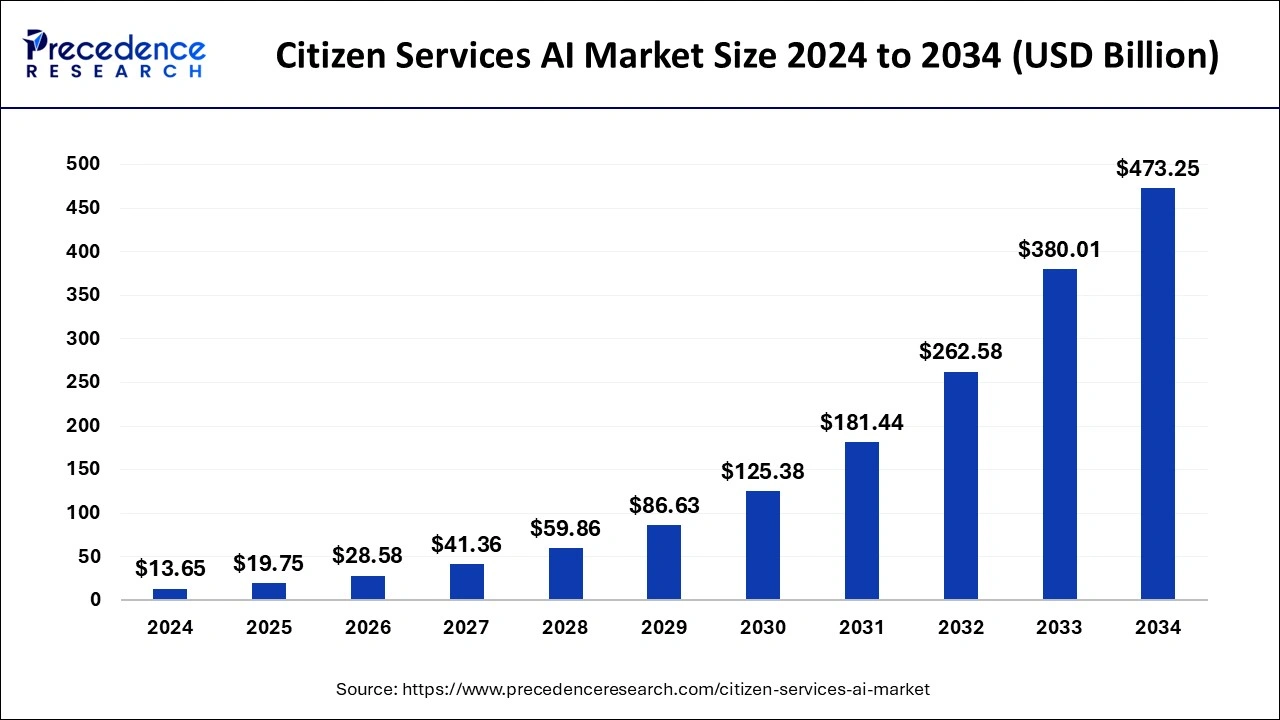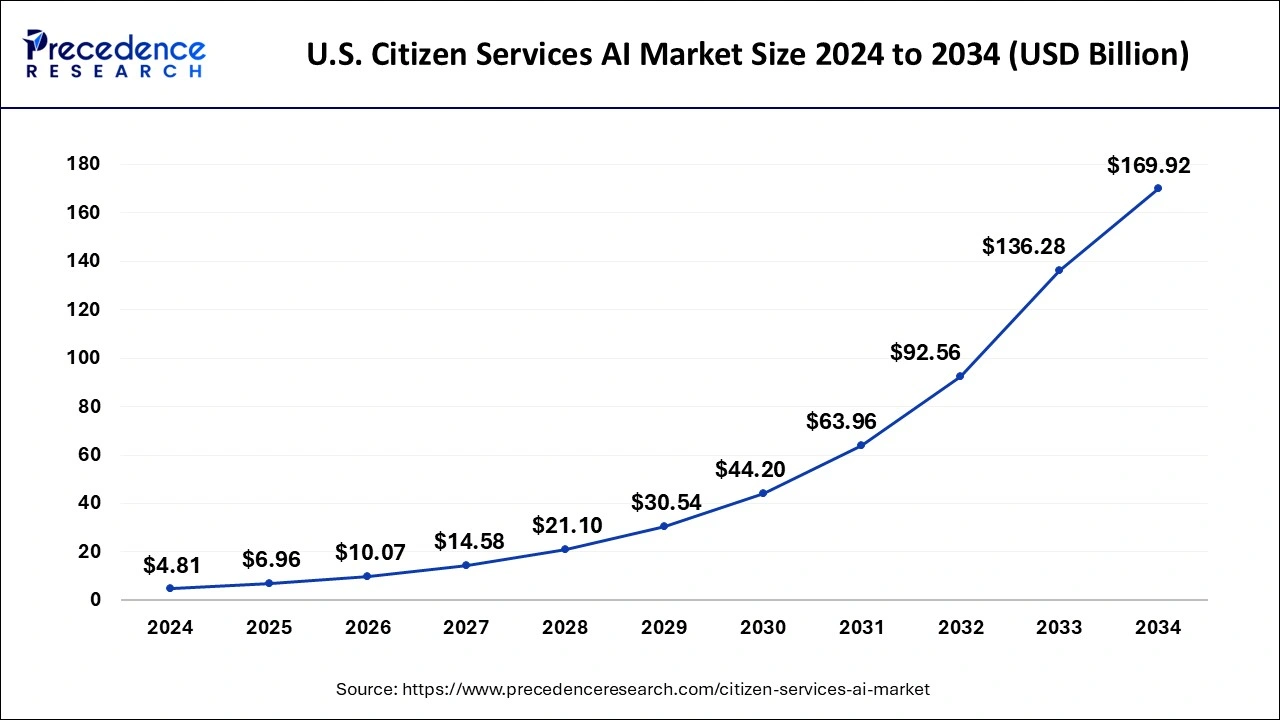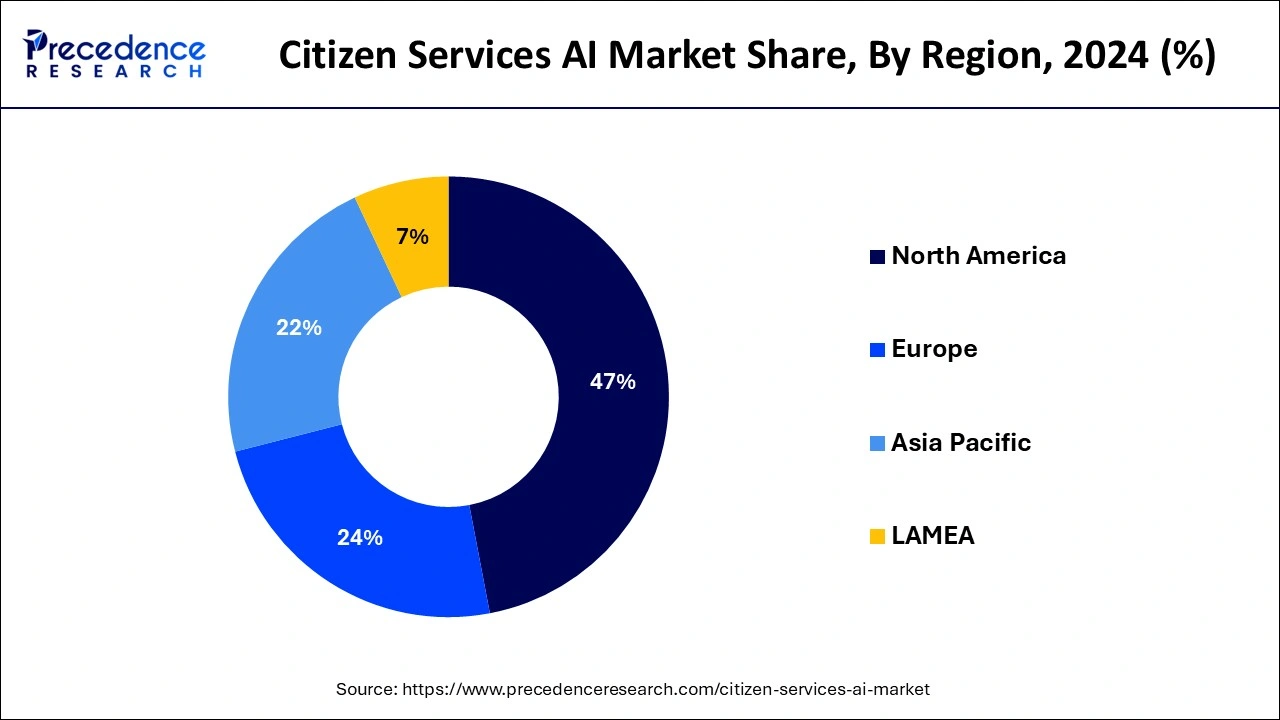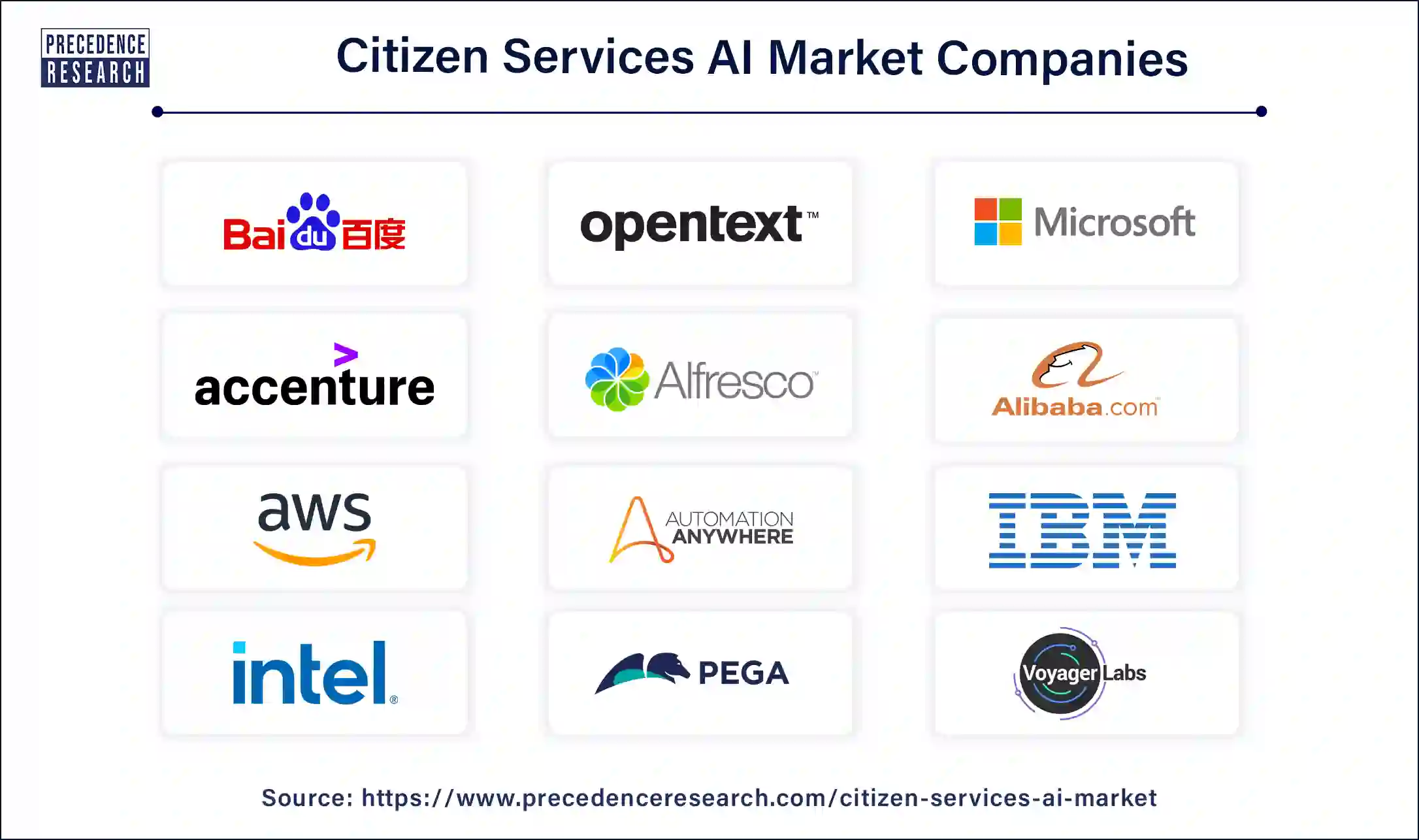List of Contents
Citizen Services AI Market Size and Forecast 2025 to 2034
The global citizen services AI market size was calculated at USD 13.65 billion in 2024 and is expected to reach around USD 473.25 billion by 2034. The market is expanding at a solid CAGR of 42.56% over the forecast period 2025 to 2034. Government organizations can save a lot of money by using automation to eliminate the need for a large workforce. Operational costs are reduced via effective resource management and predictive maintenance.

Citizen Services AI Market Key Takeaways
- The global citizen services AI market was valued at USD 13.65 billion in 2024.
- It is projected to reach USD 473.25 billion by 2034.
- The market is expected to grow at a CAGR of 42.56% from 2025 to 2034.
- North America dominated the market with the largest revenue share of 47% in 2024.
- Asia Pacific is expected to host the fastest-growing market during the forecast period.
- By technology, the natural language processing (NLP) segment has held a major revenue share in 2024.
- By technology, the machine learning (ML) segment is expected to grow rapidly in the market during the forecast period.
- By application, the public safety segment led the global market in 2024.
- By application, the healthcare segment is expected to grow at the fastest rate in the market during the forecast period.
U.S. Citizen Services AI Market Size and Growth 2025 to 2034
The U.S. citizen services AI market size was calculated at USD 4.81 billion in 2024 and is projected to attain around USD 169.92 billion by 2034, poised to grow at a CAGR of 42.83% from 2025 to 2034.

North America holds the largest share of the global citizen services AI market. The rising use of AI technology by government organizations to boost citizen engagement, streamline operations, and improve service delivery is fueling the North American AI market's rapid rise. In an effort to increase productivity and enhance decision-making, governments are progressively incorporating artificial intelligence (AI) technologies into their current systems, such as chatbots, virtual assistants, and data analytics tools. Big tech firms like Google, IBM, Microsoft, AWS, and Microsoft are making significant investments in artificial intelligence (AI) technologies designed specifically for government use, such as image processing, natural language processing, and machine learning. It can be difficult and time-consuming to integrate AI solutions with the government's current infrastructure; this is usually due to the need for substantial funding and technological know-how.
The United States (U.S.) has the largest citizen services AI market in North America, largely due to the country's existing strong digital infrastructures, and extensive government activity to modernize public services. Federal and state agencies are rapidly adopting AI technologies and anticipating its capabilities for a wide variety of tasks, including chatbots for virtual assistance and predictive analytics and how the technologies enhance resource management. Innovative programs in the U.S., such as utilizing AI-enabled chatbots for public inquiries, or, alternatively, smart city technologies, complement the overall U.S. approach to improving service delivery, enhancing citizen engagement, and increasing the transparency of a variety of departments and agencies within the overall government.

Asia Pacific is expected to host the fastest-growing citizen services AI market during the forecast period. The citizen services AI market in the area is expanding quickly thanks to developments in AI technology and growing government agency usage. This market is centered on using AI to improve citizen experiences, increase efficiency, and improve public services. More advanced and efficient citizen services are being made possible by the development of AI technologies like computer vision, natural language processing, and machine learning. The need for effective and scalable public services is rising as a result of the population growth in several Asia Pacific nations. AI-powered solutions can improve citizen happiness by responding to their wants and questions in a more timely and personalized manner.
China is prominently emerging as a leader, if not the leader, in the citizen services AI market in Asia Pacific. This may be the result of heightened governmental emphasis on smart governance, the urbanization of its cities, and investments that drive a rapid adoption of AI across the public sector. The new governmental initiatives to streamline bureaucratic processes that promote smart cities and digital service responses will catalyze the adoption of extensive AI agents that provide public services in real-time . Continued innovations outlined in strategic national policies and collaborative work with technology giants are significant factors increasing the large-scale implementation of AI into citizen-facing functions.
Market Overview
The citizen services AI market is a quickly developing industry that uses AI to improve citizen interactions with government organizations and public services. Numerous applications, including process automation, intelligent data management, predictive analytics, and automated customer service, are part of this sector.
Chatbots and virtual assistants powered by AI are useful for quickly handling queries and informing citizens. Artificial intelligence (AI) models can also examine data to forecast trends, spot possible problems, and aid in decision-making. By streamlining repetitive activities, robotic process automation (RPA) increases operational efficiency. AI improves data gathering, archiving, and analysis, resulting in more intelligent decisions based on data.
In the upcoming years, considerable growth in the citizen services AI market is anticipated. The availability of cutting-edge AI technologies is expanding, government digitization initiatives are intensifying, and public expectations for better public services are rising. These are some of the factors driving this expansion.
Professionals possessing the requisite abilities to create and oversee AI systems are in short supply. It's difficult to navigate the regulatory environment and deal with moral dilemmas related to AI use. Creation of governance structures and moral standards for AI in public services. Greater cooperation in the development and application of AI solutions between governments, tech firms, and academic institutions.
Citizen Services AI Market Growth Factors
- Globally, governments are spending more money on AI to enhance public services. Two key growth drivers are efforts to improve citizen involvement and modernize government operations.
- The public expects government agencies to provide more effective, transparent, and individualized services. AI has the potential to improve service delivery by speeding up and streamlining procedures greatly.
- AI systems can lower operating expenses by automating repetitive jobs and procedures. The citizen services AI market is being driven in large part by its cost-effectiveness.
- AI's capacity to evaluate enormous volumes of data facilitates the creation of improved policies and decision-making. Governments use AI to handle and analyze massive datasets in order to provide better services.
- AI strengthens cybersecurity defenses and aids in the detection and prevention of fraud, an increasing issue for public services.
- The citizen services AI market is expanding as a result of cooperation between public and private sector organizations in the development and application of AI technologies.
- Artificial intelligence-driven chatbots and virtual assistants are becoming increasingly widely used to answer public inquiries and provide information.
- The creation of legal frameworks and policies for the application of AI in public services aids in standardizing procedures and guaranteeing moral application, which promotes the expansion of the citizen services AI market.
Market Scope
| Report Coverage | Details |
| Market Size in 2025 | USD 19.75 Billion |
| Market Size by 2034 | USD 473.25 Billion |
| Growth Rate from 2025 to 2034 | CAGR of 42.56% |
| Largest Market | North America |
| Base Year | 2024 |
| Forecast Period | 2025 to 2034 |
| Segments Covered | Technology, Technology, and Regions |
| Regions Covered | North America, Europe, Asia-Pacific, Latin America, and Middle East & Africa |
Market Dynamics
Driver
Enhanced healthcare services
Virtual consultations are made possible by AI-powered telemedicine services, which eliminate the need for in-person visits. In order to track health status and anticipate possible problems, artificial intelligence (AI) analyzes real-time patient data collected by remote monitoring equipment. To create individualized treatment programs, AI systems examine lifestyle, medical history, and genetic data.
Artificial intelligence applications in medical imaging improve the precision and speed of diagnosing diseases such as cancer, heart disease, and neurological problems. RPA allows medical staff to concentrate on patient treatment by streamlining administrative duties, including scheduling, billing, and patient registration. NLP algorithms make it easier to retrieve pertinent data from clinical notes and unstructured medical records.
Restraint
High implementation costs
The adoption of the citizen services AI market is severely hampered by high implementation costs. These expenses cover a number of items, such as infrastructure requirements, continuous maintenance requirements, and training needs, as well as the development and implementation of AI technologies. Applications for the public sector frequently need to be heavily customized in order to meet the particular requirements of various departments and agencies of government.
Customization procedures might be costly and time-consuming. Even though they help save some infrastructure expenses, cloud services are still an ongoing expense. Moreover, there may be significant upfront expenditures associated with migration and integration when switching to cloud-based solutions. High expenses might result from relying on proprietary technologies, particularly if the government organization is dependent on just one vendor for service and upgrades. This drives the growth of the citizen services AI market.
Opportunity
Transportation and traffic management
Due to the citizen services AI market, cities are now able to manage their transportation systems with greater efficiency, safety, and user experience thanks to the application of artificial intelligence (AI) in traffic and transportation management. AI-driven solutions are becoming essential for handling the complexity of urban transportation in the context of citizen services. With developments in autonomous cars, real-time data analytics, and the Internet of Things, the application of AI in transportation and traffic management is expected to increase. Collaboration between the public and commercial sectors will be essential for fostering innovation and resolving issues. It's expected that the key priorities will continue to be increasing efficiency, maintaining a user-centric approach to urban mobility, and boosting sustainability.
Technology Insights
The natural language processing (NLP) segment held the largest share of the citizen services AI market in 2024. Chatbots with NLP capabilities are capable of addressing a broad spectrum of citizen inquiries, offering prompt assistance, and alleviating the burden on human personnel. These chatbots can help with a variety of tasks, including assisting individuals with form completion, navigating government websites, and providing answers to frequently asked queries. Large document volumes can be processed and analyzed by NLP, which can swiftly extract pertinent information to answer questions from the public.
Delivering precise responses entails interpreting legal texts, rules, and policy papers. Real-time translation of texts and chats is made possible by natural language processing (NLP), which also fosters inclusivity in various communities by opening up services to non-native speakers. Governments can assess public opinion, pinpoint urgent problems, and enhance service delivery by using natural language processing (NLP) to examine social media, polls, and feedback forms.
The machine learning (ML) segment is expected to grow rapidly in the citizen services AI market during the forecast period. The way governments and public sector organizations provide services to citizens is being revolutionized by the use of machine learning (ML) in the citizen services AI industry. Machine learning systems examine traffic trends in order to predict traffic jams, recommend different routes, and optimize signal timings. ML is used by intelligent garbage collection systems to improve collection routes and timetables based on consumption trends and bin fill levels. Chatbots driven by AI offer citizens round-the-clock support by effectively managing questions and completing service requests. By examining patterns and abnormalities, machine learning algorithms identify fraudulent activity in domains such as benefit claims and tax filings. Machine learning models assist in the implementation of mitigation methods by predicting air quality levels and identifying sources of pollution.
Application Insights
The public safety segment led the global citizen services AI market in 2024. Within citizen services, the term "AI market" describes the use of artificial intelligence (AI) technologies to improve public safety services' efficacy, efficiency, and responsiveness. This covers public safety operations such as emergency response, law enforcement, and catastrophe management. Artificial intelligence (AI)-driven surveillance systems use object detection, behavior analysis, and facial recognition to keep an eye on public areas. These technologies improve the capacity to react quickly to incidents by detecting suspicious activity and immediately notifying authorities. By analyzing data to detect disease outbreaks, forecast health trends, and keep an eye on environmental threats, artificial intelligence (AI) assists public health activities. AI-powered platforms improve community and public safety agency communication.
The healthcare segment is expected to grow at the fastest rate in the citizen services AI market during the forecast period. The demand for more accessible, individualized, and efficient healthcare services combined with artificial intelligence breakthroughs has caused the healthcare industry to grow significantly within the citizen services AI market.
AI programs are able to evaluate patient data and make tailored treatment recommendations. These systems consider numerous aspects, such as lifestyle, genetic composition, and past medical history. AI-powered solutions are lessening the workload for medical staff and cutting down on errors by optimizing administrative tasks like patient scheduling, invoicing, and claims processing. AI chatbots and virtual health assistants offer patients round-the-clock assistance by responding to their questions, reminding them when to take their medications, and giving them general health advice.
Citizen Services AI Market Companies

- IBM
- ServiceNow
- AWS
- NVIDIA
- Microsoft
- Intel
- Alfresco
- Waymo
- Voyager Labs
- Accenture
- Alibaba
- Tencent
- Pegasystems
- Baidu
- Automation Anywhere
- OpenText
Leaders Announcements
- In March 2025, Infosys, a global leader in next-generation digital services and consulting announced the expansion of its long-standing strategic collaboration with Citizens, one of the oldest and largest financial institutions in the US. Citizens will leverage Infosys' deep domain expertise in financial services and its innovative technologies, including AI, cloud, and automation to develop cloud native domain platforms and achieve data center exit.
(Source: https://www.prnewswire.com) - In March 2025, Wipro Limited, announced new Agentic AI services to empower nations around the globe to develop and deploy artificial intelligence (AI) capabilities leveraging their unique infrastructure, data, workforce and business networks to drive innovation, economic growth and sovereignty. A wide range of applications through an Agentic AI powered ecosystem, that can transform citizen experiences.
(Source: https://www.wipro.com)
Recent Developments
- In February 2025, Tata Communications has partnered with CoRover.ai, and announced development of a chatbot platform, to deliver ‘sovereign' AI solutions for Indian enterprises and government bodies. This Partnership prioritise governance and aim to aid government bodies in managing citizen services. The partnership will leverage Tata Communications' AI Cloud and CoRover's conversational AI to provide the solutions.
(Source: https://www.medianama.com) - In March 2025, The Haryana government has introduced an AI-powered chatbot, ‘Sarathi,' to provide citizens with direct access to government documents and policies. The AI system is expected to reduce delays in accessing official information, making governance more transparent.
(Source: https://apacnewsnetwork.com) - In January 2025, the UK government presented a bold strategy to use AI and technology in public services to increase productivity, simplify processes, and save a lot of money. The Prime Minister's Plan for Change is anticipated to benefit greatly from the £45 billion in yearly productivity savings that this reorganization will bring about.
- In September 2024, the Telangana government and social media behemoth Meta announced a two-year collaboration to improve citizen services and e-governance via artificial intelligence (AI) technology. In order to improve e-governance and citizen services, the strategic alliance will provide residents and public officials with the newest cutting-edge technology, such as artificial intelligence, according to a release.
Segment Covered in the Report
By Technology
- Machine Learning (ML)
- Natural Language Processing (NLP)
- Image Processing
- Face Recognition
By Application
- Traffic and Transportation Management
- Healthcare
- Public Safety
- Utilities
- General Services
By Geography
- North America
- Asia Pacific
- Europe
- Latin America
- Middle East & Africa
For inquiries regarding discounts, bulk purchases, or customization requests, please contact us at sales@precedenceresearch.com
Frequently Asked Questions
Ask For Sample
No cookie-cutter, only authentic analysis – take the 1st step to become a Precedence Research client